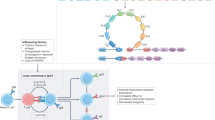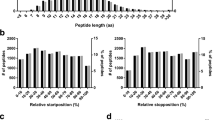Abstract
The non-classical Human leukocyte antigen G (HLA-G) differs from classical HLA class I molecules by its low genetic diversity, a tissue-restricted expression, the existence of seven isoforms, and immuno-inhibitory functions. Most of the known functions of HLA-G concern the membrane-bound HLA-G1 and soluble HLA-G5 isoforms, which present the typical structure of classical HLA class I molecule: a heavy chain of three globular domains α1–α2–α3 non-covalently bound to β-2-microglobulin (B2M) and a peptide. Very little is known of the structural features and functions of other HLA-G isoforms or structural conformations other than B2M-associated HLA-G1 and HLA-G5. In the present work, we studied the capability of all isoforms to form homomultimers, and investigated whether they could bind to, and function through, the known HLA-G receptors LILRB1 and LILRB2. We report that all HLA-G isoforms may form homodimers, demonstrating for the first time the existence of HLA-G4 dimers. We also report that the HLA-G α1–α3 structure, which constitutes the extracellular part of HLA-G2 and HLA-G6, binds the LILRB2 receptor but not LILRB1. This is the first report of a receptor for a truncated HLA-G isoform. Following up on this finding, we show that the α1–α3-Fc structure coated on agarose beads is tolerogenic and capable of prolonging the survival of skin allografts in B6-mice and in a LILRB2-transgenic mouse model. This study is the first proof of concept that truncated HLA-G isoforms could be used as therapeutic agents.




Similar content being viewed by others
References
Carosella ED, Rouas-Freiss N, Paul P, Dausset J (1999) HLA-G: a tolerance molecule from the major histocompatibility complex. Immunol Today 20(2):60–62
Carosella ED, Favier B, Rouas-Freiss N, Moreau P, Lemaoult J (2008) Beyond the increasing complexity of the immunomodulatory HLA-G molecule. Blood 111(10):4862–4870. doi:10.1182/blood-2007-12-127662
Ellis SA, Sargent IL, Redman CW, McMichael AJ (1986) Evidence for a novel HLA antigen found on human extravillous trophoblast and a choriocarcinoma cell line. Immunology 59(4):595–601
Kirszenbaum M, Djoulah S, Hors J, Le Gall I, de Oliveira EB, Prost S, Dausset J, Carosella ED (1997) HLA-G gene polymorphism segregation within CEPH reference families. Hum Immunol 53(2):140–147. doi:10.1016/S0198-8859(97)00038-4
Kirszenbaum M, Djoulah S, Hors J, Prost S, Dausset J, Carosella ED (1999) Polymorphism of HLA-G gene and protein. J Reprod Immunol 43(2):105–109
Kovats S, Main EK, Librach C, Stubblebine M, Fisher SJ, DeMars R (1990) A class I antigen, HLA-G, expressed in human trophoblasts. Science 248(4952):220–223
Mallet V, Blaschitz A, Crisa L, Schmitt C, Fournel S, King A, Loke YW, Dohr G, Le Bouteiller P (1999) HLA-G in the human thymus: a subpopulation of medullary epithelial but not CD83(+) dendritic cells expresses HLA-G as a membrane-bound and soluble protein. Int Immunol 11(6):889–898
Selmani Z, Naji A, Zidi I, Favier B, Gaiffe E, Obert L, Borg C, Saas P, Tiberghien P, Rouas-Freiss N, Carosella ED, Deschaseaux F (2008) Human leukocyte antigen-G5 secretion by human mesenchymal stem cells is required to suppress T lymphocyte and natural killer function and to induce CD4+CD25highFOXP3+ regulatory T cells. Stem Cells 26(1):212–222. doi:10.1634/stemcells.2007-0554
Verloes A, Van de Velde H, LeMaoult J, Mateizel I, Cauffman G, Horn PA, Carosella ED, Devroey P, De Waele M, Rebmann V, Vercammen M (2011) HLA-G expression in human embryonic stem cells and preimplantation embryos. J Immunol 186(4):2663–2671. doi:10.4049/jimmunol.1001081
Menier C, Rabreau M, Challier JC, Le Discorde M, Carosella ED, Rouas-Freiss N (2004) Erythroblasts secrete the nonclassical HLA-G molecule from primitive to definitive hematopoiesis. Blood 104(10):3153–3160. doi:10.1182/blood-2004-03-0809
Paul P, Rouas-Freiss N, Khalil-Daher I, Moreau P, Riteau B, Le Gal FA, Avril MF, Dausset J, Guillet JG, Carosella ED (1998) HLA-G expression in melanoma: a way for tumor cells to escape from immunosurveillance. Proc Natl Acad Sci USA 95(8):4510–4515
Lila N, Carpentier A, Amrein C, Khalil-Daher I, Dausset J, Carosella ED (2000) Implication of HLA-G molecule in heart-graft acceptance. Lancet 355(9221):2138. doi:10.1016/S0140-6736(00)02386-2
Wiendl H, Feger U, Mittelbronn M, Jack C, Schreiner B, Stadelmann C, Antel J, Brueck W, Meyermann R, Bar-Or A, Kieseier B, Weller M (2005) Expression of the immune-tolerogenic major histocompatibility molecule HLA-G in multiple sclerosis: implications for CNS immunity. Brain 128(Pt 11):2689–2704
Aractingi S, Briand N, Le Danff C, Viguier M, Bachelez H, Michel L, Dubertret L, Carosella ED (2001) HLA-G and NK receptor are expressed in psoriatic skin: a possible pathway for regulating infiltrating T cells? Am J Pathol 159(1):71–77. doi:10.1016/S0002-9440(10)61675-6
Lozano JM, González R, Kindelán JM, Rouas-Freiss N, Caballos R, Dausset J, Carosella ED, Peña J (2002) Monocytes and T lymphocytes in HIV-1-positive patients express HLA-G molecule. AIDS 16(3):347–351
Lafon M, Prehaud C, Megret F, Lafage M, Mouillot G, Roa M, Moreau P, Rouas-Freiss N, Carosella ED (2005) Modulation of HLA-G expression in human neural cells after neurotropic viral infections. J Virol 79(24):15226–15237. doi:10.1128/JVI.79.24.15226-15237.2005
Colonna M, Navarro F, Bellón T, Llano M, García P, Samaridis J, Angman L, Cella M, López-Botet M (1997) A common inhibitory receptor for major histocompatibility complex class I molecules on human lymphoid and myelomonocytic cells. J Exp Med 186(11):1809–1818
Colonna M, Samaridis J, Cella M, Angman L, Allen RL, O’Callaghan CA, Dunbar R, Ogg GS, Cerundolo V, Rolink A (1998) Human myelomonocytic cells express an inhibitory receptor for classical and nonclassical MHC class I molecules. J Immunol 160(7):3096–3100
Rajagopalan S, Long EO (1999) A human histocompatibility leukocyte antigen (HLA)-G-specific receptor expressed on all natural killer cells. J Exp Med 189(7):1093–1100
Rouas-Freiss N, Gonçalves RM, Menier C, Dausset J, Carosella ED (1997) Direct evidence to support the role of HLA-G in protecting the fetus from maternal uterine natural killer cytolysis. Proc Natl Acad Sci USA 94(21):11520–11525
Riteau B, Rouas-Freiss N, Menier C, Paul P, Dausset J, Carosella ED (2001) HLA-G2, -G3, and -G4 isoforms expressed as nonmature cell surface glycoproteins inhibit NK and antigen-specific CTL cytolysis. J Immunol 166(8):5018–5026
Riteau B, Menier C, Khalil-Daher I, Sedlik C, Dausset J, Rouas-Freiss N, Carosella ED (1999) HLA-G inhibits the allogeneic proliferative response. J Reprod Immunol 43(2):203–211. doi:S0165-0378(99)00034-0
Bainbridge DR, Ellis SA, Sargent IL (2000) HLA-G suppresses proliferation of CD4(+) T-lymphocytes. J Reprod Immunol 48(1):17–26. doi:S0165-0378(00)00070-X
Bahri R, Hirsch F, Josse A, Rouas-Freiss N, Bidere N, Vasquez A, Carosella ED, Charpentier B, Durrbach A (2006) Soluble HLA-G inhibits cell cycle progression in human alloreactive T lymphocytes. J Immunol 176(3):1331–1339. doi:176/3/1331
LeMaoult J, Caumartin J, Daouya M, Favier B, Le Rond S, Gonzalez A, Carosella E (2007) Immune regulation by pretenders: cell-to-cell transfers of HLA-G make effector T cells act as regulatory cells. Blood 109(5):2040–2048
Caumartin J, Favier B, Daouya M, Guillard C, Moreau P, Carosella ED, LeMaoult J (2007) Trogocytosis-based generation of suppressive NK cells. EMBO J 26(5):1423–1433. doi:10.1038/sj.emboj.7601570
Ristich V, Liang S, Zhang W, Wu J, Horuzsko A (2005) Tolerization of dendritic cells by HLA-G. Eur J Immunol 35(4):1133–1142. doi:10.1002/eji.200425741
Gros F, Cabillic F, Toutirais O, Maux AL, Sebti Y, Amiot L (2008) Soluble HLA-G molecules impair natural killer/dendritic cell crosstalk via inhibition of dendritic cells. Eur J Immunol 38(3):742–749. doi:10.1002/eji.200736918
Liang S, Ristich V, Arase H, Dausset J, Carosella ED, Horuzsko A (2008) Modulation of dendritic cell differentiation by HLA-G and ILT4 requires the IL-6–STAT3 signaling pathway. Proc Nat Acad Sci USA 105(24):8357–8362. doi:10.1073/pnas.0803341105
LeMaoult J, Krawice-Radanne I, Dausset J, Carosella ED (2004) HLA-G1-expressing antigen-presenting cells induce immunosuppressive CD4+T cells. Proc Natl Acad Sci USA 101(18):7064–7069. doi:10.1073/pnas.0401922101
Gregori S, Tomasoni D, Pacciani V, Scirpoli M, Battaglia M, Magnani CF, Hauben E, Roncarolo MG (2010) Differentiation of type 1 T regulatory cells (Tr1) by tolerogenic DC-10 requires the IL-10-dependent ILT4/HLA-G pathway. Blood 116(6):935–944. doi:10.1182/blood-2009-07-234872
Agaugue S, Carosella ED, Rouas-Freiss N (2011) Role of HLA-G in tumor escape through expansion of myeloid-derived suppressor cells and cytokinic balance in favor of Th2 versus Th1/Th17. Blood 117(26):7021–7031. doi:10.1182/blood-2010-07-294389
Boyson JE, Erskine R, Whitman MC, Chiu M, Lau JM, Koopman LA, Valter MM, Angelisova P, Horejsi V, Strominger JL (2002) Disulfide bond-mediated dimerization of HLA-G on the cell surface. Proc Natl Acad Sci USA 99(25):16180–16185. doi:10.1073/pnas.212643199
Gonen-Gross T, Achdout H, Gazit R, Hanna J, Mizrahi S, Markel G, Goldman-Wohl D, Yagel S, Horejsí V, Levy O, Baniyash M, Mandelboim O (2003) Complexes of HLA-G protein on the cell surface are important for leukocyte Ig-like receptor-1 function. J Immunol 171(3):1343–1351
Shiroishi M, Kuroki K, Ose T, Rasubala L, Shiratori I, Arase H, Tsumoto K, Kumagai I, Kohda D, Maenaka K (2006) Efficient leukocyte Ig-like receptor signaling and crystal structure of disulfide-linked HLA-G dimer. J Biol Chem 281(15):10439–10447. doi:10.1074/jbc.M512305200
Juch H, Blaschitz A, Daxböck C, Rueckert C, Kofler K, Dohr G (2005) A novel sandwich ELISA for alpha1 domain-based detection of soluble HLA-G heavy chains. J Immunol Methods 307(1–2):96–106. doi:10.1016/j.jim.2005.09.016
Morales PJ, Pace JL, Platt JS, Langat DK, Hunt JS (2007) Synthesis of beta(2)-microglobulin-free, disulphide-linked HLA-G5 homodimers in human placental villous cytotrophoblast cells. Immunology 122(2):179–188. doi:10.1111/j.1365-2567.2007.02623.x
Morales PJ, Pace JL, Platt JS, Phillips TA, Morgan K, Fazleabas AT, Hunt JS (2003) Placental cell expression of HLA-G2 isoforms is limited to the invasive trophoblast phenotype. J Immunol 171(11):6215–6224
Clements CS, Kjer-Nielsen L, Kostenko L, Hoare HL, Dunstone MA, Moses E, Freed K, Brooks AG, Rossjohn J, McCluskey J (2005) Crystal structure of HLA-G: a nonclassical MHC class I molecule expressed at the fetal-maternal interface. Proc Natl Acad Sci USA 102(9):3360–3365. doi:10.1073/pnas.0409676102
Shiroishi M, Kuroki K, Rasubala L, Tsumoto K, Kumagai I, Kurimoto E, Kato K, Kohda D, Maenaka K (2006) Structural basis for recognition of the nonclassical MHC molecule HLA-G by the leukocyte Ig-like receptor B2 (LILRB2/LIR2/ILT4/CD85d). Proc Natl Acad Sci USA 103(44):16412–16417. doi:10.1073/pnas.0605228103
Paul P, Rouas-Freiss N, Moreau P, Cabestre FA, Menier C, Khalil-Daher I, Pangault C, Onno M, Fauchet R, Martinez-Laso J, Morales P, Villena AA, Giacomini P, Natali PG, Frumento G, Ferrara GB, McMaster M, Fisher S, Schust D, Ferrone S, Dausset J, Geraghty D, Carosella ED (2000) HLA-G, -E, -F preworkshop: tools and protocols for analysis of non-classical class I genes transcription and protein expression. Hum Immunol 61(11):1177–1195. doi:S0198-8859(00)00154-3
Riteau B, Moreau P, Menier C, Khalil-Daher I, Khosrotehrani K, Bras-Goncalves R, Paul P, Dausset J, Rouas-Freiss N, Carosella ED (2001) Characterization of HLA-G1, -G2, -G3, and -G4 isoforms transfected in a human melanoma cell line. Transplant Proc 33(3):2360–2364. doi:S0041134501020218
Robertson MJ, Cochran KJ, Cameron C, Le JM, Tantravahi R, Ritz J (1996) Characterization of a cell line, NKL, derived from an aggressive human natural killer cell leukemia. Exp Hematol 24(3):406–415
Bird LA, Peh CA, Kollnberger S, Elliott T, McMichael AJ, Bowness P (2003) Lymphoblastoid cells express HLA-B27 homodimers both intracellularly and at the cell surface following endosomal recycling. Eur J Immunol 33(3):748–759. doi:10.1002/eji.200323678
Liang S, Baibakov B, Horuzsko A (2002) HLA-G inhibits the functions of murine dendritic cells via the PIR-B immune inhibitory receptor. Eur J Immunol 32(9):2418–2426. doi:10.1002/1521-4141(200209)32:9<2418:AID-IMMU2418>3.0.CO;2-L
Favier B, HoWangYin KY, Wu J, Caumartin J, Daouya M, Horuzsko A, Carosella ED, LeMaoult J (2011) Tolerogenic function of dimeric forms of HLA-G recombinant proteins: a comparative study in vivo. PLoS One 6(7):e21011. doi:10.1371/journal.pone.0021011
Jones DC, Kosmoliaptsis V, Apps R, Lapaque N, Smith I, Kono A, Chang C, Boyle LH, Taylor CJ, Trowsdale J, Allen RL (2011) HLA class I allelic sequence and conformation regulate leukocyte Ig-like receptor binding. J Immunol 186(5):2990–2997. doi:10.4049/jimmunol.1003078
Acknowledgments
We thank Mr. Romain Crolas, Mr. Jeremy Baudhuin, and Dr. Benoit Favier for their technical help in this project. This work was supported by Commissariat a l’Energie Atomique et aux Energies Alternatives, in part by HLA-G Technologies (to A.H.), and by National Institute of Health grant R56 AI055923 (to A. H.).
Author information
Authors and Affiliations
Corresponding author
Electronic supplementary material
Below is the link to the electronic supplementary material.
18_2012_1069_MOESM1_ESM.pptx
Supplementary material Phenotype of the NKL-LILRB1+ and NKL-LILRB1+LILRB2+ cells.Cytometry analysis of the cell-surface expression of LILRB1 and LILRB2 receptors on NKLLILRB1+ and NKL-LILRB1+LILRB2+ cells 3 (PPTX 100 kb)
Rights and permissions
About this article
Cite this article
HoWangYin, KY., Loustau, M., Wu, J. et al. Multimeric structures of HLA-G isoforms function through differential binding to LILRB receptors. Cell. Mol. Life Sci. 69, 4041–4049 (2012). https://doi.org/10.1007/s00018-012-1069-3
Received:
Revised:
Accepted:
Published:
Issue Date:
DOI: https://doi.org/10.1007/s00018-012-1069-3




